Why You Can’t Rely on Resistance Properties to Predict Charge Generation
A Southern California company installed ESD flooring in their research labs. As part of the lab commissioning protocols, they hired a third party to test the static-control properties of their new floor. The third-party measured electrical resistance per ESDA standard test method ANSI/ESD STM 7.1. Tests included point-to-point (RTT) and point-to-ground (RTG) measurements. The resistance tests verified that the floor measured below 1.0 x 107, easily complying with the resistive properties of a static-control floor based on ANSI/ESD S20.20 (Figure 1).
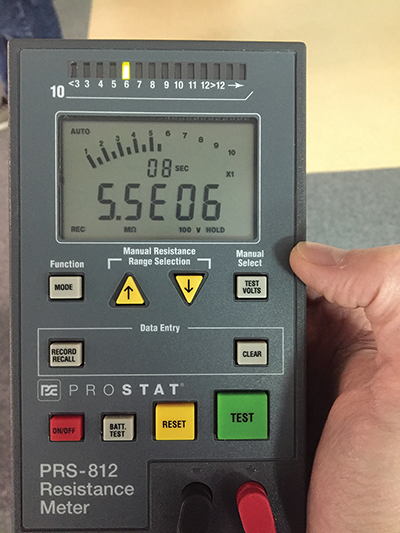
As an added service, the third party also tested the same floor for charge generation properties on a person walking on the static-control floor while wearing conductive heel straps. This second type of test, often referred to as the walking test, is normally conducted in a lab at low humidity during the qualification phase of selecting an ESD floor. In this case, however, the test was performed on an already installed floor at ambient conditions of over 40% relative humidity (RH).
Despite the favorable humidity conditions, the vinyl floor in the lab failed to meet the human body voltage limit of 100 volts. In fact, the average measured voltage on a person wearing heel straps exceeded 300 volts (Figure 2). In a facility that provided electronics manufacturing services, this floor would not be in compliance with ISO quality standards. To demonstrate best practices and retain customers, the provider would need to remove this floor or coat it with an acceptable alternative.
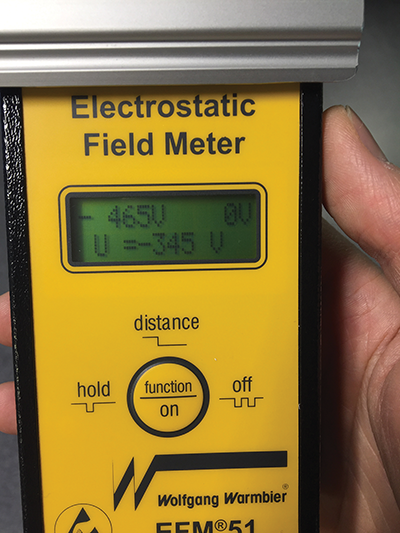
Why would a floor measuring approximately 5 meg‑ohms to ground allow the generation of such high charges on multiple test subjects wearing properly functioning heel straps? Worse, why wasn’t the floor properly qualified before it was installed?
Understanding and Following ANSI/ESD 20.20 Prevents Problems Before They Happen
The latest revisions to ANSI/ESD S20.20 altered the way we qualify ESD flooring. Prior to 2014, flooring buyers trying to meet S20.20 relied heavily, and often solely, upon measuring electrical resistive properties. Based on certain resistive metrics, it was possible—and too often the de facto methodology—to qualify a floor without ever testing voltage generation on a person.
As long as the floor measured less than 1.0 X 109 ohms, per ANSI/ESD STM 7.1, and provided system resistance of less than 3.5 x 107 ohms, per ANSI/ESD STM 97.1, it was assumed that the floor met the ≤ 100 volts threshold for charge generation. This combination of RTG and system resistance was believed to provide an adequate picture of a floor’s ability to control static charges on people wearing ESD footwear.
Charge generation – also called walking body voltage – had to be verified only in situations where the floor measured below 1.0 x 109 resistance to ground (RTG) and above 3.5 x 107 for system resistance per the ANSI/ESD S97.1 test method.
Below is an excerpt from Table 2 of the 2007 ANSI/ESD S20.20 personnel grounding requirements for a static control floor:
2007 Method 1 Qualification requirements
| Flooring/Footwear System – Method 1 | ANSI/ESDSTM97.1 | < 3.5 x 107 ohms |
OR
2007 Method 2
| Flooring/Footwear System – Method 2 (both required) |
ANSI/ESDSTM97.1 | < 109 ohms |
| ANSI/ESDSTM97.2 | <⊇100 volts |
For many flooring materials, the combination of RTG and system resistance was, in fact, an excellent predictor of the floor’s ability to prevent charges on a person wearing ESD footwear. However, when evaluating some of the most commonly installed floors, such as conductive floors manufactured with static-generating base materials, relying solely upon resistive properties proved to be a mistake.
Conductive and dissipative epoxy coatings were a case in point. Epoxy coatings are typically installed in layers. Three-layer systems consist of an insulative primer as a base layer, a heavily carbon-loaded, highly conductive primer as a middle layer, and a semi-dissipative topcoat. The theory behind the design of these floors is that static charges will naturally flow from the less conductive topcoat to the highly conductive mid-layer. In other words, static charges would follow the path of least resistance.
Until 2014, these epoxy flooring systems received acceptable grades. When tested for resistive properties per S7.1 and S97.1, the combination of a highly conductive primer covered with a thin semi-dissipative top layer yielded excellent resistance to ground measurements. Many of these floors measured below 1.0 x 107 and often measured in the conductive range < 1.0 X 106. Sometimes they even measured too conductive, despite that the top layer is only marginally dissipative and, in some cases, even
semi-insulative.
What enables a semi-conductive surface to appear conductive during a resistance test? Ohm-meters contain a power supply for applying the test voltage to the surface of the material under test. When testing resistance, a floor is subjected to an electrical DC current. The combination of voltage and current enables the output voltage from the ohm meter to punch through the topcoat to the conductive primer layer. This phenomenon can create misleading results because a material can have a thin outer layer measuring in the insulative range and yet, as part of an aggregate, still measure as a conductive composite material due to the highly conductive middle layer.
 What is System Resistance? What is System Resistance?System resistance measures the resistance to ground (ohms) of a person standing on a floor, wearing static control footwear. System resistance measures the person, the footwear they’re wearing, the contact resistance of the floor surface, and the resistance to ground of the floor covering. Multiple tests should be conducted with the test subject wearing every type of footwear that will be allowed in the space. System resistance must measure less than 1.0 x 109. |
Resistance Tests Do Not Reliably Predict Charge Generation
When we test the resistive properties of ESD flooring, we are examining the flooring material’s ability to resist or facilitate the flow of electricity. If the floor’s resistance is over one billion ohms (1.0 x 109), the floor is considered inadequate for use in an ANSI/ESD S20.20 program because electricity flows at a rate considered too slow. If the floor’s measurement is too conductive (e.g., < 2.5 x 104), some standards, such as FAA 019f, Motorola R56, and ATIS 0600321-2015, may assess the floor covering as potentially unsafe for use around energized equipment in-flight towers, telecommunications and dispatch operations.
Conductivity, however, informs us only about whether or not the floor provides a path to ground and how resistive that path may be. You might say resistance is an indirect indicator of static control mitigation performance. It does not measure whether or not a floor will actually prevent the generation of static electricity in the first place.
Even highly conductive floors, when made from a combination of conductive additives or matrices surrounded by insulative base materials, can generate substantial static charges on people wearing certain types of footwear. For example, the previously mentioned multilayer conductive epoxy provides a walking surface that contains far more insulative materials than conductive ones. If someone wore shoes with synthetic soles on that epoxy floor, for instance, there would be no electrical contact between the floor and the person’s body due to the insulative quality of the shoe sole materials. Therefore, providing no path to ground.
As the person walked, the contact and separation between the insulative materials on the epoxy surface and insulative shoe soles would generate static and those charges would accumulate on the person’s body. The same dynamic holds true for high-pressure laminates and ESD vinyl floors that are coated with maintenance-enhancing polyurethane sealers. When the actual top surface is comprised of charge generating materials like polyurethane surface protectors, the floor can and will generate static charges on a person, even if he or she is wearing certain types of ESD footwear.
Footwear can also contribute to inaccuracies
If a person were wearing heel straps over insulative shoe soles, the conductive heel strap would form an electrical bond with the conductive particles in the floor, with the ribbon that tucks inside the shoe touching human skin, completing the circuit and, in most cases, preventing static from building as the person walked. Suppose while walking she lifted both heels off the floor. In this case, the toe of the insulative shoe sole would be the only contact with the floor, and there would be no electrical continuity, no path to ground, and static could build as she walked on the floor. This is why static-control floors should be made with low-generating materials.
Why a Floor Can Pass Resistive Tests and Still Produce Excessive Body Voltage
There are multiple reasons for why a floor could pass resistive test criteria and still produce excessive (>100 volts) walking body voltage. Additional scenarios are addressed in the following sections
The topcoat of the floor is insulative
In other words, the majority of the contact-walking surface is a static generator. With some epoxy coatings, for example, the top layer is composed of a thin insulative material that allows people to generate body voltages (See Generation 2 epoxy, Figure 3). This phenomenon also occurs on conductive and static-dissipative vinyl floors that feature low-maintenance polyurethane/ceramic surface (PU) coatings. With friction, these easy-maintenance coatings tribocharge footwear materials—regardless of the conductivity of the footwear.
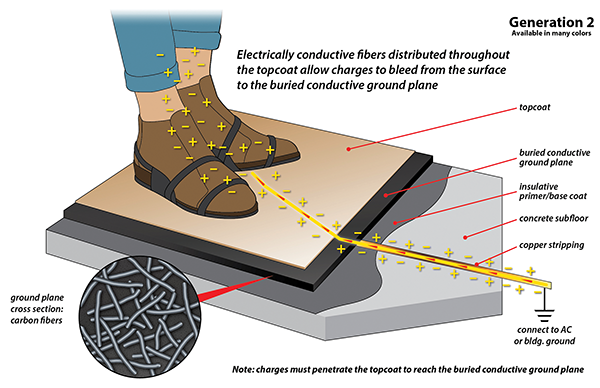
Recommendation? Always test floors per ANSI/ESD S20.20 recommendations before they are installed.
The flooring material passed body voltage generation parameters but was tested with a particular type of footwear
Some static-dissipative and conductive flooring materials produce widely varying results when tested with different types of ESD footwear. For instance, multi-layer epoxies and conductive vinyl products with low-maintenance coatings may comply with the new ANSI/ESD test parameters. But these floors perform well only when tested with the subject wearing specific conductive shoes with full conductive soles.
In the test data presented in Figure 4, a conductive vinyl interlocking floor was advertised as meeting ANSI/ESD S20.20. However, the floor prevented body voltages above 100 volts only when tested with ESD shoes. In tests with heel straps, the same floor generated 827 volts. To put this scenario in perspective, a conductive rubber floor in the same test prevented voltages from exceeding 10 volts regardless of the type of conductive footwear worn by the subject.

Recommendation? Always ask what type of footwear was used for the tests cited in the flooring brochure and specification sheet.
Tests were not conducted or were conducted incorrectly in the qualification phase.
ESD footwear manufacturers do not specify which types of ESD flooring materials are compatible with their products. This places the burden of proof on the end user. ANSI/ESD S20.20-2014 recognizes the importance of flooring not being evaluated or selected as a single component. The floor is clearly part of a flooring-footwear system. Testing in the qualification phase (as opposed to post-installation verification testing), in which test subjects wear each type of footwear that will be allowed in the space, is a must.
Many flooring buyers don’t test the footwear they will use until after their floor has been installed. This means they rely on performance claims from the flooring manufacturer without knowing which type of footwear was used in the tests. You could say that they have inadvertently provided the supplier with the responsibility of qualifying the flooring for them. As a result, they don’t know what they’ve purchased until it’s too late. Qualification testing should be comprehensive and should always include multiple types of footwear. The best process would involve third-party lab testing.
Recommendation? Ask for third-party lab reports involving multiple types of footwear.
The floor was qualified in conjunction with ESD shoes but was not tested with heel straps.
Heel straps cover only part of a shoe sole, with the majority of foot-to-floor surface contact occurring between the unprotected portion of the shoe sole and the floor. Because the sole of the street shoe is the main contact surface with the floor, heel straps often exhibit the highest body voltage generation. This is due to the insulative portion of standard footwear generating charges from contact and separation with the ESD floor. During the walking test, even if the heel strap is in contact with the flooring material, the exposed insulative shoe sole can tribocharge when it contacts and separates from certain flooring surfaces.
Because permitted footwear options sometimes change after the floor has been installed, floors should always be qualified with multiple footwear options, including heel straps, regardless of whether heel straps are intended for use.
Recommendation? Qualify the ESD floor with multiple footwear options. If a floor meets best practices only with specific footwear, this limits footwear options and prevents changing footwear in the future. A visitor wearing heel straps, for instance, will generate static (and accumulate charges) on a floor that performs only with ESD shoes.
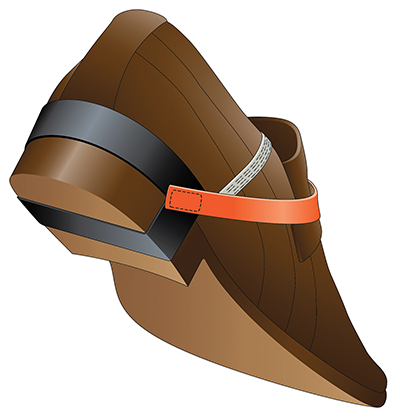
Qualification tests were performed in the buyer’s facility as opposed to in a controlled lab environment.
This is the scenario where most buyers and sellers of ESD flooring go wrong. Many buyers of ESD flooring invite flooring manufacturers to install test patches so they can compare performance in their facility. This approach may work well for researching maintenance and durability and sampling color and texture. The facility is not, however, the right place to perform walking body voltage tests at the qualification level. For starters, guidelines for qualification testing require the humidity to be controlled to 15% +/- 3% for at least 72 hours, to eliminate the influence of high humidity on test results.
Some flooring materials are made with chemicals that gather moisture from high humidity, increasing the conductivity of the flooring material. Moisture-gathering chemicals become less effective over time or leach out of the material, raising electrical resistance. Materials, including some ESD vinyl products, require special waxes that perform well at high humidity and poorly at low humidity. Conditioning samples at low RH exposes these shortcomings, prevents false readings and reveals deficiencies.
Tests conducted in the end user’s facility are rarely done under the proper ambient conditions, particularly before a facility is occupied. For this reason, results are always more reliable when tests are performed at controlled conditions in an independent lab.
Recommendation? During the qualification phase, have the flooring material under evaluation tested by an independent lab at low RH.
Qualifying a Product vs. Verifying a Product (or Testing Compliance)
Since 2014, S20.20 has required testing for body voltage generation when we qualify a floor. Product qualification, the first step in selecting an ESD floor, ensures that flooring materials under consideration meet ESD requirements laid out in the ANSI/ESD S20.20 standard. Qualification methods include review of specifications and either independent or internal lab evaluation or testing, utilizing standard test methods, STM 7.1, STM 97.1 and STM 97.2.
To meet the standard, resistance measurements for the flooring and footwear/flooring system must measure 1.0 x 109 or below, with charge generation not exceeding 100 volts. All tests must be conducted with the subject wearing whatever type of ESD footwear has been designated for use in the space.
Body Voltage Measurements Test Actual Performance
The protocols set out in ANSI/ESD S20.20 are intended to provide the framework for an ESD prevention program. This standard covers the requirements necessary to design, establish, implement, and maintain an ESD-control program to protect electrical or electronic parts, assemblies, and equipment susceptible to ESD damage from human body model (HBM) discharges greater than or equal to 100 volts.
Charge Generation (Body Voltage) Test
The purpose of the charge generation test (also known as the walking body voltage test) is to determine if a person wearing specific types of static-control footwear will maintain a static charge maximum below 100 volts when walking on a static control floor.
This test is conducted in a controlled environment at a humidity of 15% plus or minus 3%. All materials used in the test must be conditioned in the lab for a minimum of 72 hours. Performing this test in the factory at ambient conditions is not adequate for qualification of new, uninstalled ESD flooring.
Equipment and Set-Up
The walking test requires connecting a test subject to a voltage-measuring device such as a charge plate monitor. The voltage-measuring device needs to be connected to a data collection device (Figure 6).
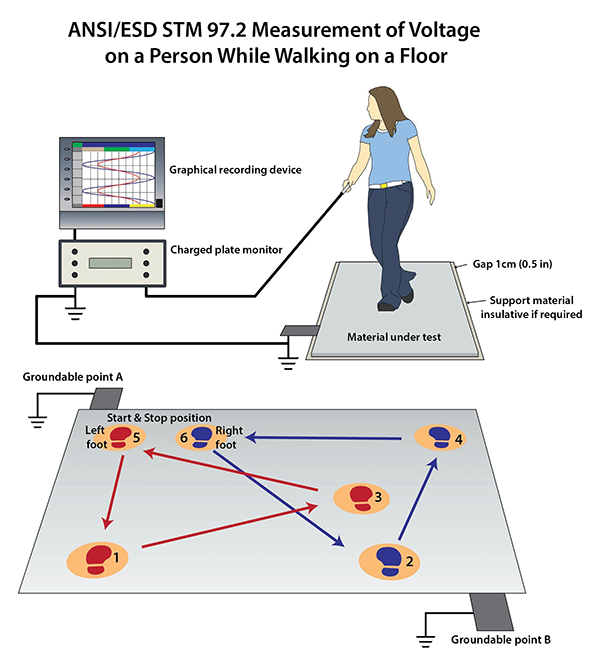
The walking motion used in the test should resemble the motions people would make during their routine work activities. For example, stepping forward and backward, striding and moving from side to side. The test does not include scuffing and dragging shoe soles. While conducting the test, the subject should attempt to restrict lifting her feet to no more than about three inches. For consistency and statistical validity, the same motions should be duplicated over and over again for 10 complete 6-step cycles per test. Three tests should be performed per sample.
Footwear Matters
To meet qualification and compliance requirements in S20.20, flooring materials must be tested in conjunction with whatever ESD footwear is designated for use in the space. It is important that the test subject wears whatever footwear will be permitted in the space, or multiple types of footwear allowed for use in the space because test results can vary depending upon the flooring/footwear combination.
Some flooring materials, tested per 97.2, perform very well with ESD shoes but poorly with ESD heel straps. Other floors perform better with ESD heel straps than with ESD shoes. There is no absolute correlation between a specific footwear flooring combination. For that reason, every combination under consideration should be tested at the qualification phase.

It’s All About the Voltage
“This standard covers the requirements necessary to design, establish, implement and maintain an Electrostatic Discharge (ESD) Control Program for activities that manufacture, process, assemble, install, package, label, service, test, inspect or otherwise handle electrical or electronic parts, assemblies and equipment susceptible to damage by electrostatic discharges greater than or equal to 100 volts Human Body Model (HBM) and 200 volts Charged Device Model (CDM).”
– From ANSI/ESD S20.20
The forward of ANSI/ESD S20.20-2014 clearly states that the standard was created to prevent body voltage above 100 volts. So, the next time a salesperson shows you that their floor meets 20.20 by using an ohm-meter, ask for the lab test data for body voltage generation.
Once again, the most reliable and objective data comes from third-party test labs. As one facilities director pointed out recently, you can deal with HVAC problems, a roof that leaks, or a bad layout, but you can’t run your manufacturing operation if a floor fails. Leave qualification to the experts – not the supplier, not the salesperson, and definitely not the buyer!
Conclusions
- Resistive properties do not predict body voltage generation;
- Floors generate significantly different magnitudes of static charges depending on the type of ESD footwear used during testing;
- Floors should be carefully qualified per ANSI/ESD S20.20 before they are installed; and
- Humidity influences charge generation during the STM 97.2 walking test. Relying on data collected at ambient conditions may be misleading.
Recommendations
- Recognize the difference between qualification and verification;
- Beware of flooring materials with buried conductive layers and low maintenance surface coatings.
- Make sure the qualification covers all your footwear possibilities;
- Question literature and data; and
- Ask for a lab report with your footwear.
Suggestions for Further Discussion
- Floors should not be chosen based on categories; floors should not be selected based solely on whether they measure in the conductive range or the dissipative range.
- Test results should always include the types of footwear used for testing when posting results.
- ESD flooring marketing materials should clearly distinguish test results that were obtained as qualification data or verification data.
- Heel straps are still the most common type of ESD footwear used in the ESD prevention programs. Flooring footwear combination testing should include common ESD footwear options like heel straps.
- Third parties – not suppliers – should perform qualification certification.
- Is it wise to continue categorizing floors as either conductive or dissipative?
